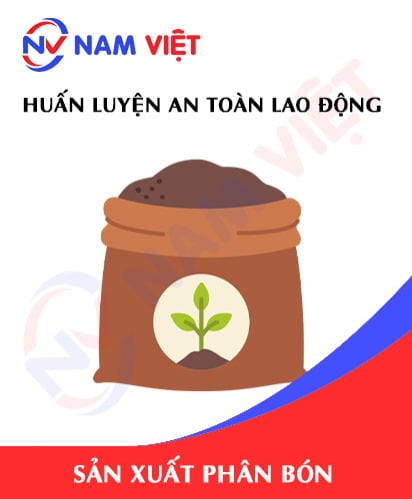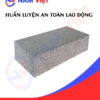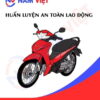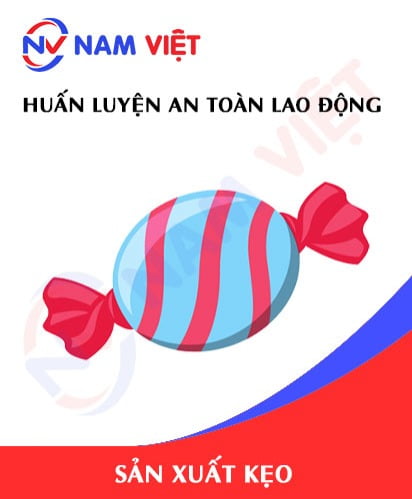Occupational safety training for fertilizer manufacturing
99,000 ₫
Note: The above price is calculated per person, the price may fluctuate depending on the number of learners participating in the course and the market movement, for more accurate price support please refer to the pricing table or contact our consultants directly.
Occupational safety is an important issue in factories manufacturing fertilizer and needs to be addressed promptly to ensure the health and safety of workers, enhancing the reputation of businesses. The Safety training course is one of the effective solutions to raise awareness about how to prevent occupational accidents for workers involved in manufacturing fertilizer.
Table of Contents
Toggle1. Overview of fertilizers
a. What are fertilizers?
- Fertilizers are products used to provide essential nutrients for plants and help increase yield and product quality. Fertilizers can include nutrients such as nitrogen, phosphorus, potassium, copper, manganese, zinc, iron and other trace elements.
- These nutrients help plants grow better, achieve high yields and have better quality. In addition, fertilizers also have the effect of protecting plants from diseases and pests.
- The fertilizer production industry in Vietnam is considered to be an industry with strong development potential in the near future, thanks to the increasing demand for fertilizer use in the agricultural sector.
- According to statistics from the Ministry of Agriculture and Rural Development, domestic fertilizer production has been steadily increasing in recent years. In 2020, fertilizer production reached more than 11.6 million tons, an increase of 5.1% compared to 2019. At the same time, Vietnam’s fertilizer exports also grew rapidly and are present in many markets around the world.

b. Types of fertilizer production machinery
The types of fertilizer production machinery include:
- Stone crushers: used to crush limestone and phosphate rock into small powder.
- Dryers: used to dry fertilizers after they have been mixed.
- Mixers: used to mix the fertilizer ingredients together.
- Presses: used to press fertilizer pellets into different shapes such as round, cylindrical, spherical.
- Packaging machines: used to pack fertilizers into packaging such as bags, sacks, barrels, boxes.
- Waste treatment machines: used to treat waste generated during the fertilizer production process.
These machines are designed and manufactured to ensure that the fertilizer production process is carried out according to the correct technical process and ensures the safety of the operator.

c. Typical fertilizer production enterprises
In Vietnam, there are many fertilizer production enterprises, including typical ones such as:
- PetroVietnam Fertilizer and Chemicals Joint Stock Corporation (PVFCCo): This is one of the leading enterprises in the production and supply of fertilizers, chemicals and industrial gases in Vietnam. PVFCCo produces fertilizers such as urea, DAP, NPK, organic fertilizers, phosphorus fertilizers, potassium fertilizers, foliar fertilizers…
- Binh Dien Fertilizer and Chemicals Joint Stock Company (BFC): As one of the leading fertilizer production units in Vietnam, BFC produces organic fertilizers, NPK fertilizers, foliar fertilizers, phosphorus fertilizers, potassium fertilizers and many other types of fertilizers.
- Ha Bac Fertilizer Joint Stock Company (Habaco): Habaco is known as one of the largest fertilizer production enterprises in the North of Vietnam. Habaco’s fertilizer products include organic fertilizers, NPK fertilizers, phosphorus fertilizers, potassium fertilizers…
- Southern Fertilizer Joint Stock Company (SFC): SFC is one of the largest fertilizer production enterprises in the South of Vietnam. SFC’s fertilizer products include urea, DAP, NPK, organic fertilizers, phosphorus fertilizers, potassium fertilizers, foliar fertilizers…
- Duc Giang Chemicals and Fertilizers Joint Stock Company (DGC): DGC was established in 1960 and is one of the oldest fertilizer production enterprises in Vietnam. DGC’s fertilizer products include urea, DAP, NPK, organic fertilizers, foliar fertilizers…
The above are some typical fertilizer production enterprises in Vietnam, but there are many other enterprises operating in the fertilizer production industry in Vietnam.
d. Specific jobs in a fertilizer production factory
Group 1
- Executive director, deputy executive director, department manager in a fertilizer production factory.
Group 2
- Safety officer: manages safety in the factory, designs safety procedures, supervises and urges employees to comply with safe working procedures.
Group 3
- Recycling and chemical treatment: Employees must ensure safety during the process of recycling old chemicals and treating them according to regulations.
- Crushing and sieving: This process involves using a crusher to crush raw materials such as limestone, sedimentary rocks,..and then sieving the crushed particles.
- Mixing and shaping: The fertilizer particles are mixed together to form a complete fertilizer. Workers need to use specialized machines to mix the ingredients and shape the fertilizer.
- Packaging and boxing: After the fertilizer has been shaped, it is packaged in bags and boxes for preservation and transportation.
- Quality control: Some fertilizer production factories use measuring devices to check the quality of fertilizers such as moisture, pH,..and other factors.
- Equipment maintenance and repair: Technicians need to regularly maintain and repair equipment in the factory to ensure the safety of workers and production efficiency.
Group 4
- Office, service, sales, and marketing jobs.
- Quality management, human resource management, material management, accounting and financial management.
- Production management: Managers need to manage the production process and ensure compliance with safety and environmental regulations.
- Research and development of new products, designing product packaging.

2. Overview of occupational safety training for fertilizer manufacturing
Within the scope of this article, we focus on issues surrounding group 3, because group 3 is the group that directly participates in the production process, bearing the highest risk of occupational safety. You can refer to other groups here
a. What is group 3 occupational safety training?
- Occupational safety training for group 3 consists of sessions that equip employees with awareness of how to prevent labor accidents.
- The occupational safety training course will help employees recognize and prevent dangers, and limit the risks of labor accidents occurring while working.
REGISTER FOR OCCUPATIONAL SAFETY TRAINING SERVICE
b. Training time
First-time safety training time
- Total training time is at least 24 hours, including the test time.
- 8 hours of theoretical study on the policy and legal system on occupational safety and hygiene
- 8 hours of theoretical study on basic knowledge of occupational safety and hygiene
- 4 hours of theoretical study on specialized training content
- 2 hours of practical study on specialized training content
- 2 hours of theoretical testing at the end of the training course
The safety training center will allocate the time into many training sessions depending on the time arrangement for employees. But usually, there will be 6 training sessions, the course will take place over 3 days, provided that the manufacturing enterprise can arrange continuous learning time.
Periodic safety training time
- Before the occupational safety card expires, if the employee wants to be re-issued, they must undergo a periodic occupational safety training course, with the periodic safety training time being at least 50% of the first-time safety training time.
Explanation: the total periodic occupational safety training time is at least 12 hours, including the test time. After completing the periodic training course and passing the test, the employee will be re-issued or have their occupational safety card renewed.
c. Content of the training course
| No. | TRAINING CONTENT | TRAINING TIME (HOURS) | |||
| Total | Of which | ||||
| Theory | Practice | Inspection | |||
| I | Policy and legal system on occupational safety and hygiene | 8 | 8 | 0 | 0 |
| 1 | Overview of the system of legal documents on occupational safety and hygiene. | 6 | 6 | ||
| 2 | System of technical standards and regulations on occupational safety and hygiene. | 1 | 1 | ||
| 3 | Specific regulations of state management agencies on occupational safety and hygiene when newly building, expanding or renovating works, facilities to manufacture, use, preserve, store and inspect types of machines, equipment, materials, and substances with strict requirements on occupational safety and hygiene. | 1 | 1 | ||
| II | Basic knowledge of occupational safety and hygiene | 8 | 8 | 0 | 0 |
| 1 | Basic knowledge of dangerous and harmful factors in the workplace. | 4 | 4 | ||
| 2 | Methods to improve working conditions. | 1 | 1 | ||
| 3 | Safety culture in manufacturing and business. | 1 | 1 | ||
| 4 | Rights and obligations of the employer, employee; policies and regulations on occupational safety and hygiene for employees; functions and duties of the safety and hygiene network. | 1 | 1 | ||
| 5 | Occupational safety and hygiene rules, signs, safety and hygiene signs and use of safety equipment, personal protective equipment; skills and techniques for first aid for labor accidents, prevention of occupational diseases. | 1 | 1 | ||
| III | Specialized training content | 6 | 4 | 2 | 0 |
| General knowledge about types of machines, equipment, and substances that generate dangerous and harmful factors; analysis, assessment, and management of risks in occupational safety and hygiene, safe working procedures with machines, equipment, and substances with strict requirements on occupational safety and hygiene. | 6 | 4 | 2 | ||
| IV | Inspection of safety training content at the end of the training course | 2 | 2 | 0 | 0 |
| Total | 24 | 22 | 2 | ||
See more training content of 6 groups
d. Occupational safety card
After completing the occupational safety training course and passing the test, the employee will be issued an occupational safety card (in practice, it is often called a group 3 occupational safety certificate).
The group 3 safety card will clearly show information such as: full name, date of birth, job and specific working environment. It also includes the training time, a red stamp, and a signature confirming the completion of the training course.
According to the regulations on issuing safety cards specified in clause 2 of article 24 of Decree 44/2016/ND-CP, there are two cases:
- If the employer and the employee have a labor contract, the employer must sign, stamp and affix a seal on the safety card for the trained person in group 3 after they complete the training course from the occupational safety training unit and pass the test.
- If the employee is a freelancer, seasonal worker, and does not have a labor contract, the training unit must sign, stamp and affix a seal on the safety card for the employee after they complete the training course from the occupational safety training unit and pass the test.

3. Recognizing dangers when manufacturing fertilizers
Fertilizer production can encounter the following dangers:
- During the fertilizer production process, chemical substances such as ammonia, phosphate and potassium can be hazardous to the health of workers. These substances can cause irritation to the skin, eyes, respiratory system and digestive system.
- The fertilizer production process often generates dust, especially when using production machinery. This dust can be hazardous to the health of workers if inhaled into the lungs, causing respiratory problems.
- Fertilizer production equipment such as grinders, mills and conveyor belts can be hazardous to the health of workers if not used correctly. If not regularly maintained, the equipment can cause labor accidents.
- During the fertilizer production process, chemical reactions can create high temperatures and pressures, posing a danger to workers. It is necessary to ensure safety in the process of controlling temperature and pressure.
- Chemical substances in the fertilizer production process can cause fires and explosions if not handled correctly. This can lead to danger for workers and the environment.
4. Common labor accidents when manufacturing fertilizers
Common labor accidents in fertilizer production factories include:
- Explosions, fire and explosions: The use of chemical substances to produce fertilizers can lead to the risk of fire and explosions. Packaged fertilizers can explode if they are impacted, collide or are exposed to high temperatures.
- Contact with toxic chemicals: Workers producing fertilizers come into contact with toxic chemicals, which can affect their health, such as nitrate, phosphate and potassium compounds.
- Risk of accidents during machinery operation: Accidents related to fertilizer production machinery can occur, such as accidents caused by cutting, impact, or flying materials.
- Risk of environmental pollution: Fertilizer factories can cause environmental pollution if waste is not handled correctly.
- Health risks for workers: Workers in fertilizer factories are at risk of suffering from respiratory and skin diseases, because they have to work in an environment with toxic gases and come into contact with toxic chemicals.
- Risk of fire and explosion due to electricity: Fertilizer factories have a lot of electrical equipment and wiring, so the risk of fire and explosion due to electricity is also very high.
5. Safety measures when participating in fertilizer manufacturing
The safety measures when participating in fertilizer production are as follows:
- Before proceeding with fertilizer production, it is necessary to ensure that workers are fully trained on the potential dangers in the production process, the use of protective equipment and other safety measures.
- Fertilizer factories need to be fully equipped with protective equipment for workers, including masks, face masks, safety glasses, cleanroom suits, gloves, safety boots and helmets.
- It is necessary to ensure safe working conditions, including ensuring cleanliness, ventilation, sufficient light, no noise and no toxic air.
- Fertilizer factories need to ensure proper waste management and treatment to avoid environmental pollution.
- Fertilizer production equipment needs to be checked and maintained periodically to ensure worker safety.
- Fertilizer factories need to comply with safety regulations and laws related to fertilizer production, transportation and storage.
- Fertilizer factories need to provide occupational safety training for employees on fire prevention and fighting and need to have a detailed fire prevention and fighting plan.
- It is necessary to ensure safety during fertilizer transportation, use proper means of transport, supervise fertilizer during transportation and protect the surrounding environment.
- Periodically organize occupational environment monitoring in factories and enterprises, collect and analyze harmful factors to workers, thereby adjusting to reduce the level of harm to prevent occupational diseases for them.

6. Benefits of occupational safety training for fertilizer manufacturing
An Toan Nam Viet provides your business with great benefits after completing occupational safety training courses according to the provisions of Decree 44/2016/ND – CP on Occupational Safety and Hygiene work for companies, enterprises, and businesses.
- Employees can identify the potential risks of labor accidents and thereby have preventive measures to avoid labor accidents.
- Your business can establish risk prevention measures in the production, operation, and maintenance process.
- Reduce costs when there is a risk of occupational unsafety.
- Uninterrupted production will help increase labor productivity and product quality.
- Comply with occupational safety laws, avoiding legal risks.
- Create prestige and professionalism in all aspects, thereby enhancing the brand for your business.
The training courses of Nam Viet are a solution to prevent and combat external factors from affecting each individual so that they can avoid danger that can lead to injury or, more seriously, death.
REGISTER FOR OCCUPATIONAL SAFETY TRAINING SERVICE
7. Customer feedback after completing occupational safety training for fertilizer manufacturing
An Toan Nam Viet has many years of experience in the mission of accompanying many businesses in Vietnam in general and in the southern provinces in particular. And that responsibility is something extremely precious to Nam Viet, which is why Nam Viet’s Occupational Safety Training work is always focused on becoming more professional. The motivation for An Toan Nam Viet to grow strong today comes from the positive feedback and suggestions from businesses. Below are the feedbacks from our partners that we have served.
BAC NAM E&C INVESTMENT AND CONSTRUCTION JOINT STOCK COMPANY
“The first time I used An Toan Nam Viet’s service, I was very surprised by the enthusiastic 24/7 support of the team of consultants. The class organization was very quick and convenient for our company, thank you very much for An Toan Nam Viet’s service!”
HOA DAT CONSTRUCTION AND TRADING JOINT STOCK COMPANY
“Nam Viet’s service has helped us a lot in simplifying occupational safety and the work of completing safety dossiers for the working process. The team of consultants is enthusiastic and timely in answering our questions. 5 stars for Nam Viet”
See more customer interviews after using An Toan Nam Viet’s service
8. Occupational Safety Training Competence of An Toan Nam Viet
An Toan Nam Viet is a reputable and high-quality occupational safety training center in Vietnam today. With occupational safety training sessions continuously taking place at manufacturing workshops, factories or construction sites across the country (63 provinces and cities in Vietnam).
REGISTER FOR OCCUPATIONAL SAFETY TRAINING SERVICE
License for occupational safety training
- An Toan Nam Viet has been inspected and licensed by the Department of Labor Safety of the Ministry of Labor – Invalids and Social Affairs to be eligible to operate occupational safety and hygiene training. This further strengthens our capacity to operate occupational safety training.

Documents and lectures
- Before occupational safety training materials are put into occupational safety training courses, they are reviewed and censored to ensure that the lectures are always correct in terms of knowledge and effective when applied.
- The teaching method of the lecturers is synchronized according to the teaching standards of An Toan Nam Viet, which is a method that experts in the field of occupational safety and hygiene training have researched and summarized during the teaching process to bring the highest knowledge acquisition efficiency to students.
Facilities
- Controlling factors in the classroom that affect the training process will increase teaching efficiency and the effectiveness of students’ knowledge acquisition.
- Our training course support facilities always arrange spacious classrooms that meet standards for area, lighting, training equipment, etc.
9. Reputable and high-quality safety training center nationwide
At An Toan Nam Viet, we always prioritize our professional dedication to occupational safety training. For us, imparting the knowledge of self-protection to workers so they can have a safe foundation on their path to earning a living contributes to building the country.
To ensure effective training, we prepare carefully and meticulously every single detail, no matter how small. From preparing tools, equipment, and teaching devices to textbooks, documents, sound, and lighting.
Our occupational safety training lecturers are experts with many years of experience in the field. They even have research projects identifying dangers in all professions and how to prevent them.
The lecturers’ lessons are drawn from practical experience and are delivered in a lively and easy-to-visualize way for workers. These factors help workers feel comfortable during their study and absorb our teaching knowledge well. Of course, the knowledge imparted always closely follows Decree 44/2016/ND-CP.
From there, they grasp many measures to prevent dangers and how to protect themselves. At the same time, they also apply it in the most suitable way in their actual work.
Our safety training center is proud to be a reputable and professional provider of occupational safety training services with the following advantages:
- Competitive training costs while still ensuring the quality of training.
- Flexible training schedules to suit the company’s production situation.
- Fast and legally compliant procedures for issuing occupational safety training certificates.
- Our training lecturers are highly experienced professionals.
- Classrooms are controlled for factors that affect the training process, thereby increasing teaching efficiency and the effectiveness of knowledge acquisition for students.
- The lectures are compiled to be suitable for occupational safety work in various businesses.
- An Toan Nam Viet works with dedication and professionalism to provide customers with accurate and fast support.

10. Refer to more occupational safety training documents for fertilizer manufacturing
- Occupational safety documents for fertilizer manufacturing
- Occupational safety training documents
- Set of occupational safety training test questions
- Occupational safety multiple-choice test for fertilizer manufacturing
- Lecture slides for occupational safety training in fertilizer manufacturing
1 review for Occupational safety training for fertilizer manufacturing
No comments yet















namchinh.haiphong341
Hài lòng nhé!